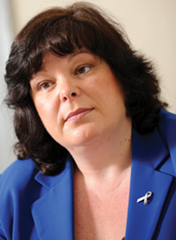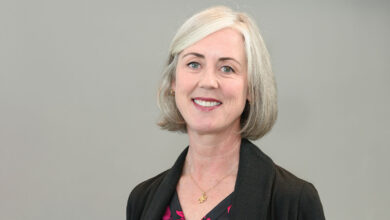Dawn Purvis: tackling disadvantage
 Dawn Purvis discusses her report’s priorities for tackling educational disadvantage, including equal funding across all levels of schooling.
Dawn Purvis discusses her report’s priorities for tackling educational disadvantage, including equal funding across all levels of schooling.
Eighteen months on from her working group’s Call to Action report on educational disadvantage, Dawn Purvis is keen that the Executive funds each level of education equally.
As an independent unionist MLA, Purvis convened a working group on educational disadvantage and the Protestant working class, which published its report in March 2011.
‘A Call to Action’ identified the underfunding of earlier stages of education as one of the system’s most serious problems. The two post-primary principals on the group agreed as they knew that when children have stable formative years, they are more ready to learn.
In 2009-2010, average expenditure per pupil or student at each level of education varied as follows:
- £4,605 nursery;
- £3,696 primary;
- £5,287 post-primary;
- £4,431 further; and
- £5,267 higher.
Recognising that it would be “extremely difficult” to fund early years more than the later years of education, the group called for the equalisation of funding between the sectors. The department has said that changing the funding system would be costly but the group disagrees.
“Obviously, there’s pain in it for some and gain in it for others,” Purvis states, “but if we’re serious about tackling this long tail of underachievement, this is public money and it’s about the best return on that investment, and it should be invested early.”
She now works as a consultant in the voluntary sector and sits on the advisory group on shared education, due to report next February.
Purvis does not want to pre-empt the group’s final report but finds that the terms of reference are wide enough to consider all that the relevant issues.
“For myself, I have quite an open mind about shared education and I think I always have,” she comments. The concept should not be “restricted to religion” and should be “based upon improving the outcomes for all children.”
‘A Call to Action’ recognised the sensitivities around focusing on one section in society. However, the report’s introduction explained that it sought to “shine a light on a serious and growing problem” which has been known for many years.
Purvis was very encouraged by how the report was received across the sector, and the initial response by the department and the Minister. Efforts had been made tackle the problem but, in her view, those responsible did not understand the problem properly. Disadvantage is very complex problem and must be addressed over the long term.
Key principles need to be set out i.e. the importance of leadership, good quality education, stability in policy from the department, engagement with children at a very early age, and parental engagement in children’s education.
The last point is “absolutely crucial”. Many parents, Purvis finds, have low confidence with some sending an older child into the school to pick up a younger child, rather than going in themselves. Schools and voluntary organisations can work together to engage with parents. Getting mothers involved is especially important, as they still have the most influence in the family as home-makers and carers.
Barnardos’ family centre in Tullycarnet, for example, is located on the same site as the local primary school and supports families with children aged 0-11. Its work has changed parents’ outlook on education and helped teachers by preparing children better for school.
“I think it is interesting, and sad in many respects, that [in] our community and voluntary sector, where all these creative ideas to address educational disadvantage are being implemented, programmes are being implemented and designed on a shoestring budget,” Purvis comments. “You can’t educate a child without engaging with their family and everything else that’s happening around them.”
Long-term studies in Scandinavia suggest that consistently supporting a family from birth (e.g. through parenting classes, and advice on healthy diet and discipline) has a major positive effect. By the age of 10, outcomes for children “are comparable to another child from a wealthier background.”





